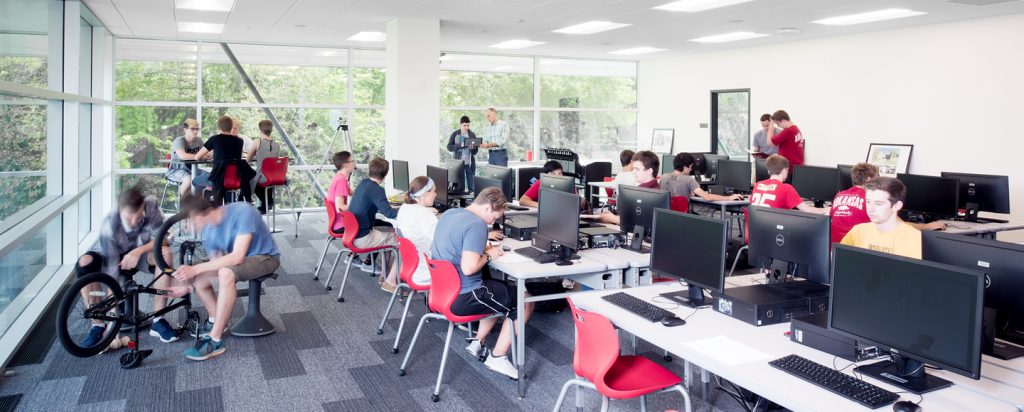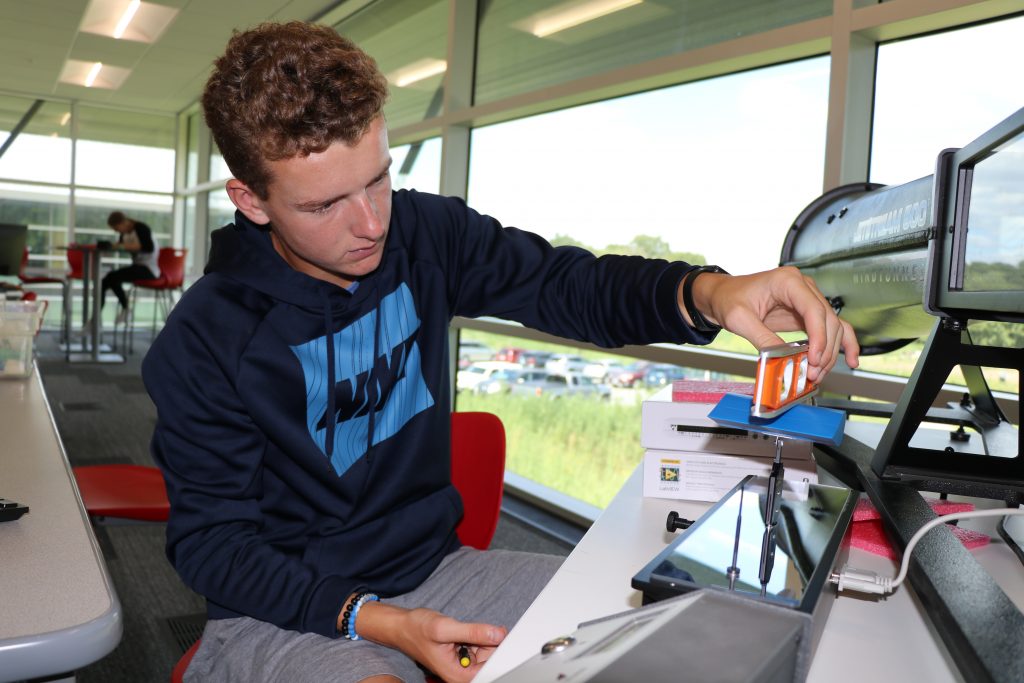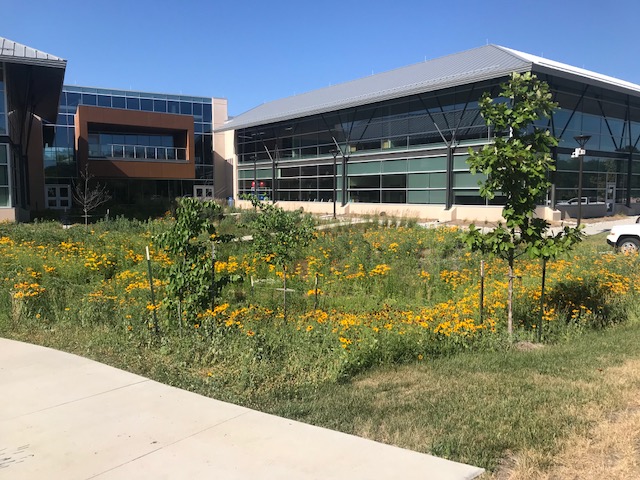By. Joan Leavens and Greg Thiel
It’s been said that if you move your body, you move your mind. So, it stands to reason that if you move into a carefully designed, inspiring, cheerful, collaborative environment, your mind will be moved in ways that you never previously imagined. This was the case when design and engineering instructor Greg Thiel moved into the Shawnee Mission School District Center for Academic Achievement (CAA) in Fall 2017. As Project Lead the Way Coordinator for Shawnee Mission School District, Thiel knows firsthand that the learning environment can tremendously influence student creativity and innovation. The CAA has proved to be a source of inspiration for him and his engineering students since stepping foot into the new building.
A Commitment to Sustainability
Shawnee Mission School District educates 27,250 students at 48 schools located in the Kansas suburbs of Kansas City, Missouri. The district made a commitment to sustainability in its five-year strategic plan with priorities centered around school gardens and natural areas; composting and recycling; transportation alternatives; health and well-being; and education, awareness, and student involvement. A coordinator of sustainability and community engagement was hired to ensure that sustainability isn’t confined to operations and maintenance but is integrated into classroom instruction and experience through professional partnerships, pre-K through grade 12.
The CAA fits squarely into the district’s focus on bridging the physical aspects of sustainability with curriculum and instruction. The building was designed to Leadership in Energy and Environmental Design (LEED) Silver specifications and constructed to be efficient and low impact. It’s a unique environment that differs from traditional schools and professional buildings as it combines district administrative offices and Career and Technical Education in a central location. This co-location offers opportunities to inspire and connect students, teachers, and administrators with one another and the community, thus opening the door to experiential, real-world learning.

A New Home for Engineering
Project Lead the Way (PLTW) Engineering was among the programs moved to the CAA. PLTW provides STEM education for preK-12 students nationally. At Shawnee Mission, students learn design thinking principles beginning in kindergarten through PLTW Launch. The curriculum emphasizes critical thinking, creativity, innovation, and real-world problem-solving. The hands-on, project-based program culminates in junior and senior level courses in Aerospace Engineering, Cybersecurity, Digital Electronics, Engineering Design and Development, and Civil Engineering and Architecture.
The CAA has proved to be an ideal location for Shawnee Mission’s engineering classes. Situated on the building’s second floor, the engineering classrooms are surrounded on two sides by floor-to-ceiling glass and look out onto a living laboratory that includes a four-acre native prairie green infrastructure stormwater system, the 1.3-acre CAA Broadmoor Urban Farm operated by the culinary program, and a bank of trees bordering the property. The corner has earned the name, “Inspiration Point.”
Thiel’s students use the CAA’s sustainable design features to inspire an array of projects. During the 2018 – 2019 school year, for example, his Civil Engineering and Architecture students were asked to propose designs for a new elementary school to be built on the site of an existing, outdated building. Working with the Center for Green Schools at the U.S. Green Building Council, students were connected with several LEED-certified professionals who helped them understand the ins and outs of the building’s design features, including building orientation, energy efficiency, air quality, heat loss and gain, LED and natural lighting, views of nature, and the healthy, multi-functional landscape. Students also interviewed a focus group of kindergartners, administrators, and parents to determine the future occupants’ interests and needs. These conversations helped students empathize with those who would be using the building and taught them the importance of safety and comfort from the perspective of those who would teach and learn in the new school.

After speaking with the LEED professionals and focus group participants, students were motivated to integrate sustainable features into their school designs, indoors and out. These features included an on-site garden, daylighting in the hallways, and indoor plants to enhance air quality. Students also used their learning about energy efficient walls and windows to guide decisions regarding building orientation and fenestration. The students designed the school site to capture water for re-use and retain water to eliminate downstream flooding and pollution.
Perhaps the most meaningful experience for students was defending their designs before a panel of experts and stakeholders. Included on the panel were the architect and civil engineer who designed the CAA, as well as the district sustainability coordinator and executive director of facilities. The panelists interacted with the students as professionals and questioned them closely about their designs. The students rose to the challenge and readily defended their decisions with confidence, convincing the professionals to further explore their innovative design suggestions.
Another project inspired by the CAA involved a team of Engineering Design and Development students who worked with culinary program students to design and construct a portable irrigation system for mushroom logs. The engineering students were motivated to take on this challenge after they learned the culinary program at the CAA Urban Farm wanted to grow shitake mushrooms for the on-site, student-run restaurant. The mushrooms would require a customized irrigation system to ensure successful growth and survival. After researching mushrooms and how they grow, the engineering students designed and constructed a PVC-pipe-based misting system for the farm’s mushroom logs. Their solution was modeled on the CAA’s two-story living wall and its built-in irrigation system, which students walk past each day on their way to class. The students were particularly proud that their solution involved and benefited many people. One student noted, “Little did we know how interdisciplinary our problem was. The logs were inoculated by CAA biotechnology students, our team designed the misting system, and the culinary students will use the mushrooms in the kitchen.”

In other projects, civil engineering students ground-truthed the CAA’s green infrastructure stormwater design by reviewing the site drawings and point checking the installation’s elevation and slope. Graphic design students researched and developed an interpretive sign that explains the native prairie landscape, its wildlife, and water quality benefits to employees and community members who walk the trail through the prairie. The information on the sign was vetted by partners from Kansas Wildlife, Parks, and Tourism and the city stormwater specialist, who will provide funding for the finished product. Engineering students will design and fabricate the pedestal that will support the sign. Client-facing projects like these give students real-world skills that have value in the marketplace.
Conclusion
Innovative, healthy, green buildings, like the CAA, invite exploration and learning and connect curriculum to cutting-edge practice. Through these environments, instructors can help students grow their green design potential by immersing them in spaces where they can experience green and sustainable design principles through careful and planned observation. You can provide similar experiences for your students, whether you teach in a green building or not. Identify building features students should look for depending on objective and curriculum. Design activities staged in multiple sites throughout the building to spark creativity as students debrief, discuss, and plan. Experiencing low-impact design concepts in site design, energy efficiency, natural lighting, and the stress-reducing impacts of nature views and indoor green walls can inspire students with self-confidence and motivation. Move their bodies and their minds. The benefits and results can be truly astonishing.
Author Bios
Greg Thiel is a Project Lead the Way instructor for the Shawnee Mission School District and has been teaching high school pre-engineering classes since 2004. He has served as a Master Teacher in Civil Engineering & Architecture for Project Lead the Way and has a passion for sustainable design.
Joan Leavens serves as coordinator of sustainability and community engagement for the Shawnee Mission School District. Joan collaborates with Curriculum, Instruction, and Assessment to integrate sustainability priorities identified by students into preK-12 curriculum, as well as implement sustainability practices in Operations and Maintenance. Joan works to connect preK-12 students to current professional practice, policy, and field study through sustainability and community engagement.

